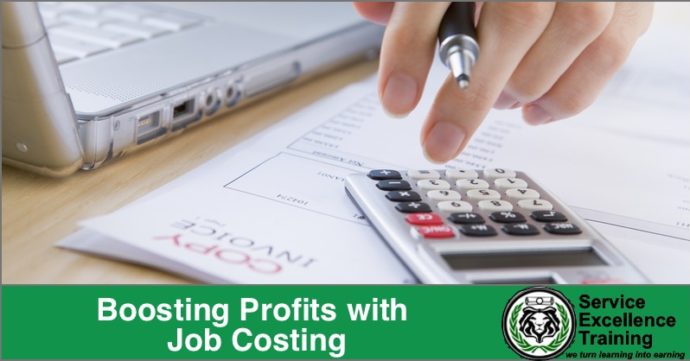Blog
3 Keys to Boosting Profits with Job Costing
By Kerry Webb • 3 Keys to Boosting Profits with Job Costing
I started working with a contractor a while ago. I was trying to help him uncover why he was not hitting his goals for net profit. We sat down and dug into the numbers. He was making a lot of sales and thought business was good. At the end of the quarter, his net profit was below the goal, even though sales were above the goal.
If you are like most contractors, then you have experienced this at one time or another. What we found after digging into the numbers is he was not priced right. His equipment and labor costs were not where they needed to be in order to reach his net profit goals. That is when we started talking about job costing.
Related: vendor negotiations
Most contractors have questions about job costing. If not, then perhaps they have not given serious thought to this valuable exercise, and the impact it makes on your net profit.
These are some of the most frequently asked questions about job costing:
- What is job costing?
- What is the goal of job costing?
- Which jobs should you bother with job costing?
- How does job costing help your business?
- How can you expedite job costing?
- What is a simple process that works?
Here are 3 Simple Keys to Boosting Profits with Job Costing:
Key 1: Accept the importance of Job Costing
First, what exactly is job costing?
For a simple answer, let’s turn to the boundless source of useful information….Wikipedia.
Job costing is the process of determining the labor and materials cost for each job in a systematic way, and then using this information to create a quote for the customer. It may also be used after the job is completed to determine if an adequate profit was achieved.
Job costing, also known as cost accounting, can be used in virtually any industry (especially the service industry) to ensure that pricing covers actual costs, overhead, and provides a profit. The purpose of a business is to make money, and job costing is the most effective way to ensure this occurs. For a typical job, direct material, labor,
• • • • • •
subcontract costs, equipment, and other direct costs are tracked at their actual values.
After overhead (direct labor) is added, the total cost for the job can be determined. Enlightened bookkeepers are moving forward and using job costing software, thereby improving cost control, reducing risk, and increasing the chance of profitability.
Wow! Is your head spinning yet? Let’s make this really easy.
What is the goal of job costing?
Job costing is the simplest way to figure out if you spent more on materials, parts, equipment, and labor than you should have. It’s more than knowing if a profit was made on the job or project. It’s knowing what your gross profit was, and if it met up to your company and industry standard.
You see, a profit is not realized until after you subtract your operating costs, management costs, and salaries from the gross profit. Hopefully, you have some funds left over and this is your net profit.
Too often companies get to the end of the year and “HOPE” they made a net profit. I have talked with too many owners who “settled” for 3-6% net profit. Sometimes they were simply happy they didn’t end up in the red for the year. This is no way to end a year filled with hard work, long hours, and management headaches.
Which jobs should you bother job costing?… All of them.
Before you quote a job, you should know what the gross profit is going to be, or at least have a very good idea. Job costing should occur BEFORE a job is quoted and AFTER the job is completed and expenses are submitted.
Key 2: Price Correctly
How does job costing help your business?
Job costing protects your profit margin on the front end of a job when you are providing prices or quotes. Then AFTER the expenses are calculated, job costing is your best tool for showing exactly what your gross profits actually are.
Would you like to know what your cost should be to obtain a net profit of up to 21%? Get the Free Super Simple Financials Download today.
Key 3: Monitor Job Costing Consistently
How can you expedite job costing?
A good pricing calculator is critical for effective job costing. If you use pricing books, then your hard costs need to be calculated on an annual basis to make sure you are retaining your gross margins. Simply raising prices by some annual percentage (say 5%) is a very poor method for protecting your gross margins on service or equipment sales.
What is a simple process for job costing that works?
Quickbooks is one of the most popular and effective tools for job costing, once your expenses and labor are computed. All of your jobs over $1,000 should be job costed after the fact. This can be achieved by printing the job costing reports from Quickbooks on a weekly or bi-weekly basis. Once a month, you want to also review the service calls for each of your technicians. It may not be realistic to review every single call, but if you review at least 3-5 calls per technician, you will quickly spot trends and know if they are pricing their service work properly.
Back to the contractor, I was talking about. Through our coaching, training, and implementation of good business practices like job costing, this client was able to increase his profits from 2% to 17%. This increase in his profit margin also included the total for our training services. The end results were a total win for the contractor. He fixed his profit problem and found the money to grow his business and change his life.
Would you Like Help with your Business?
If you still have questions, fill out the form below. Let’s have a conversation about how Service Excellence Training can help you reach your goals.
What SETs Us Apart?
Proactive Business Plans
A proactive business is a successful business. That's why our team takes the time to make sure every client has a proactive, not reactive, business plan. Our strategies make your business run more smoothly and profitable.
Proven Results
Our training services help businesses identify and achieve their key performance indicators (KPIs). Whether it's increased revenue or higher satisfaction rates, our methods allow you to see immediate and continued results.
Personalized Training
Our team of experts works hard to make sure your business gets personalized training. We'll work with your team one-on-one or in group settings to set and achieve your business goals. We develop training based on your goals!
Prioritizing People
We believe that people are the most valuable asset. We strive to provide outstanding benefits, life balance, leadership, and support to our team. We believe in helping people reach their greatest level of growth, contribution and satisfaction.

Trusted By
Business Ignition
SPARK
Classroom Training
Resources
Company

Join our newsletter











